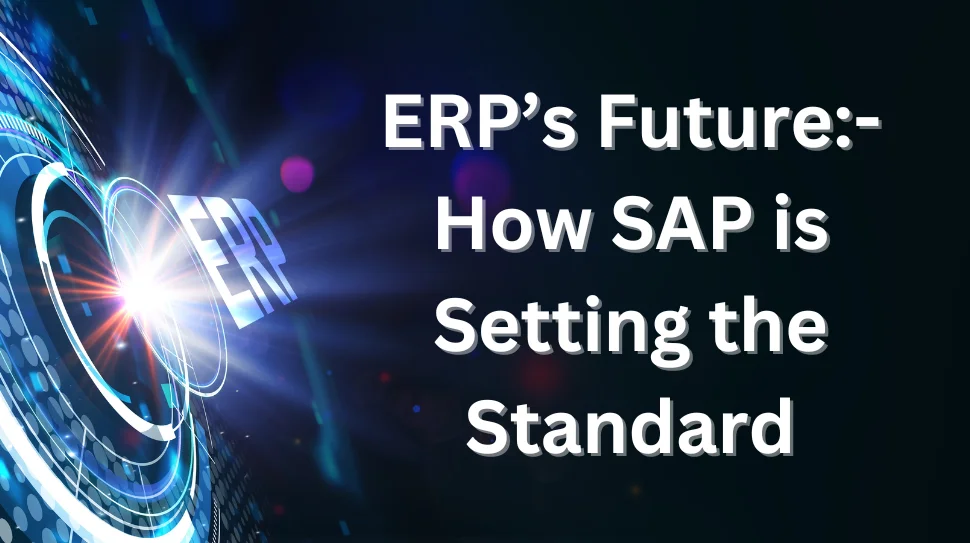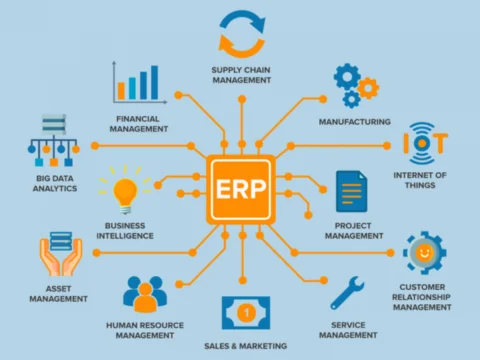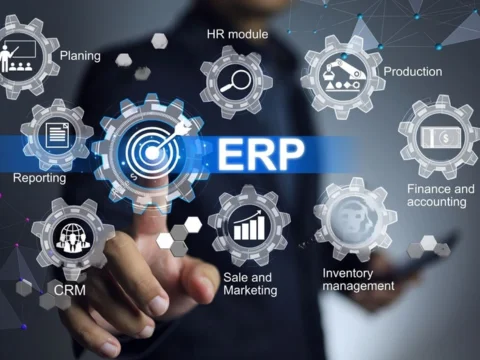ERP's Future: How SAP is Setting the Standard


Systems for enterprise resource planning, or ERPs, have long been the foundation of companies, optimizing workflows and coordinating activities among diverse divisions. With the advancement of technology, the range of ERP systems also changes. SAP, a pioneer in enterprise resource planning (ERP) worldwide, is driving this change by redefining the ERP landscape with the use of cutting-edge technology. In this blog article, we'll examine how SAP is setting the standard for ERP going forward, talking about innovations, strategic choices, and the effects on companies all across the world.
ERP (enterprise resource planning) systems, which offer a centralized platform for managing finance, HR, manufacturing, supply chain, services, and procurement, are essential to contemporary business operations. Since its founding in 1972, SAP has come to be associated with ERP. It provides reliable solutions that assist companies of all sizes in increasing productivity and streamlining their operations.
ERP systems from SAP are made to fit the needs of a wide range of industries, including manufacturing, retail, healthcare, and finance. SAP keeps innovating as the digital era develops, making sure its ERP solutions stay on the leading edge of technology.
The introduction of Material Requirements Planning (MRP) systems, which concentrated on manufacturing processes, in the 1960s marked the beginning of the path for ERP systems. Comprehensive ERP systems that integrated several corporate processes began to appear in the 1990s. ERP systems nowadays are more sophisticated, utilizing real-time data processing, cloud computing, and artificial intelligence.
In this history, SAP has been a leader, always improving and modifying its products to satisfy the shifting needs of enterprises. SAP has raised the bar for ERP systems with the release of SAP S/4HANA, a next-generation ERP suite.
The three main pillars of SAP's ERP strategy are customer-centric innovation, digital transformation, and intelligent enterprise.
By incorporating cutting-edge technology like AI, machine learning, and the Internet of Things into their ERP systems, SAP hopes to turn companies into Intelligent Enterprises. Businesses may automate procedures, obtain greater insights, and make better decisions thanks to this connectivity.
Leading the way in digital transformation, SAP assists companies in making the shift from antiquated, linear processes to more contemporary, flexible, and data-driven ones. By putting the cloud first, SAP guarantees the scalability, flexibility, and accessibility of its ERP systems, enabling seamless digital transformation.
SAP prioritizes innovation that is focused on the needs of its customers. SAP makes sure that its ERP systems are customized to match the specific demands of its clients by consistently obtaining user feedback and implementing it into their products.
SAP is utilizing these technologies to facilitate digital transformation across several industries, as they are driving the Fourth Industrial Revolution.
With its most recent ERP systems, SAP has demonstrated its dedication to innovation by integrating cutting-edge technology to provide businesses with unmatched value.
The flagship ERP package from SAP, SAP S/4HANA, is intended to operate on the SAP HANA in-memory database. This architecture enables real-time data processing and analytics, which provides businesses with rapid insights and speeds up decision-making. S/4HANA streamlines procedures and cuts down on data redundancy to simplify the IT environment.
The ability to access data and analytics quickly is crucial for taking preemptive action.
A uniform data model and a more straightforward architecture helped to reduce complexity.
SAP Fiori offers tailored user experiences and intuitive interfaces.
SAP uses AI and machine learning in its ERP systems to forecast results, streamline workflows, and automate monotonous operations. For example, SAP Cash Application reduces manual burden greatly by using machine learning to match payments to invoices automatically.
demand forecasting, trend analysis, and data-driven decision-making.
By automating repetitive duties like data input, workers are able to focus on more strategic work.
Using sophisticated analytics to deliver insights that can be put into practice.
keeping an eye on machinery in real time to identify and stop malfunctions.
Monitoring products and resources all the way through the supply chain to increase efficiency and transparency.
Gathering information from networked devices to streamline workflows and cut down on downtime.
SAP provides cost-effective, scalable, and flexible cloud-based ERP solutions. Through the cloud, companies may access their ERP systems at any time and from any location, facilitating remote work and international operations.
Easily adjust resources to meet changing company requirements.
Lower the upkeep and infrastructure expenses related to on-premise systems.
The ability to access ERP systems from any device with an internet connection makes remote work possible.
SAP's cutting-edge ERP solutions are revolutionizing business operations in a number of industries, increasing productivity, and boosting competitiveness.
SAP's ERP solutions have strong data analytics capabilities that help businesses glean insights from their data. Businesses can track performance, spot patterns, and make data-driven decisions that increase productivity and profitability using real-time analytics.
The user experience (UX) design for SAP software, SAP Fiori, offers a standardized, user-friendly, and customized experience across platforms. This contemporary UX makes navigation easier, cuts down on training time, and boosts output.
SAP's ERP solutions streamline supply chain management by combining procurement, inventory control, production, and logistics. Businesses may improve service levels, cut costs, and manage their supply chains with the use of advanced analytics and real-time data visibility.


Leading global shipping company DHL transformed its supply chain processes with SAP S/4HANA. DHL increased customer satisfaction, decreased operating expenses, and increased delivery accuracy by combining real-time data and predictive analytics.
In order to optimize its operations, Siemens, a leading global player in automation, digitalization, and electrification, implemented SAP's cloud-based ERP solutions. Siemens was able to effectively manage its worldwide operations and foster innovation because of the scalability and flexibility of SAP's cloud solutions.
Although there are many advantages to using SAP's ERP solutions, companies should be aware of possible implementation and acceptance difficulties.
Data migration from outdated systems to SAP's ERP products can be difficult and time-consuming. In order to guarantee data integrity and reduce disruptions, meticulous preparation and execution are necessary.
An organizational culture change is required as a result of implementing new ERP systems. Useful change management techniques are necessary to guarantee user acceptance and reduce resistance.
Although SAP's ERP solutions have long-term advantages, there may be a substantial upfront cost. Companies must manage their budgets by balancing expenditures with the anticipated return on investment.
With SAP setting the standard for excellence and constant innovation, the future of ERP is bright. SAP is redefining what ERP systems can do by adopting cutting-edge technologies like AI, machine learning, IoT, and cloud computing. This helps businesses run more efficiently, make wiser decisions, and maintain their competitiveness in a market that is changing quickly.
Businesses can gain a strategic edge by working with SAP as they look to the future. Strong, scalable, and adaptable ERP solutions from SAP are made to satisfy the many demands of contemporary businesses, promoting growth and digital transformation.
Investigate SAP's ERP solutions and how they may revolutionize your business processes to remain ahead of the always-shifting business landscape. For a personalized consultation, get in touch with our team of experts right now and start using SAP to move toward a more intelligent and productive future.
Through the use of SAP's innovations and strategic direction, enterprises can achieve unprecedented levels of productivity, flexibility, and competitiveness.